The Significance of Preserving Indigenous Knowledge in Modern Society
VerifiedAdded on 2019/11/14
|10
|2501
|307
Report
AI Summary
The viability of indigenous knowledge cannot be entirely replaced by scientific knowledge, as there are limits to what science can answer. The research applied both qualitative and quantitative data collection techniques to study the dynamics of Aboriginal culture and population changes. The findings highlighted the importance of preserving traditional practices and cultural heritage. Additionally, the limitations of coping strategies were discussed, emphasizing the need for resilience and adaptation in the face of adversity.
Contribute Materials
Your contribution can guide someone’s learning journey. Share your
documents today.
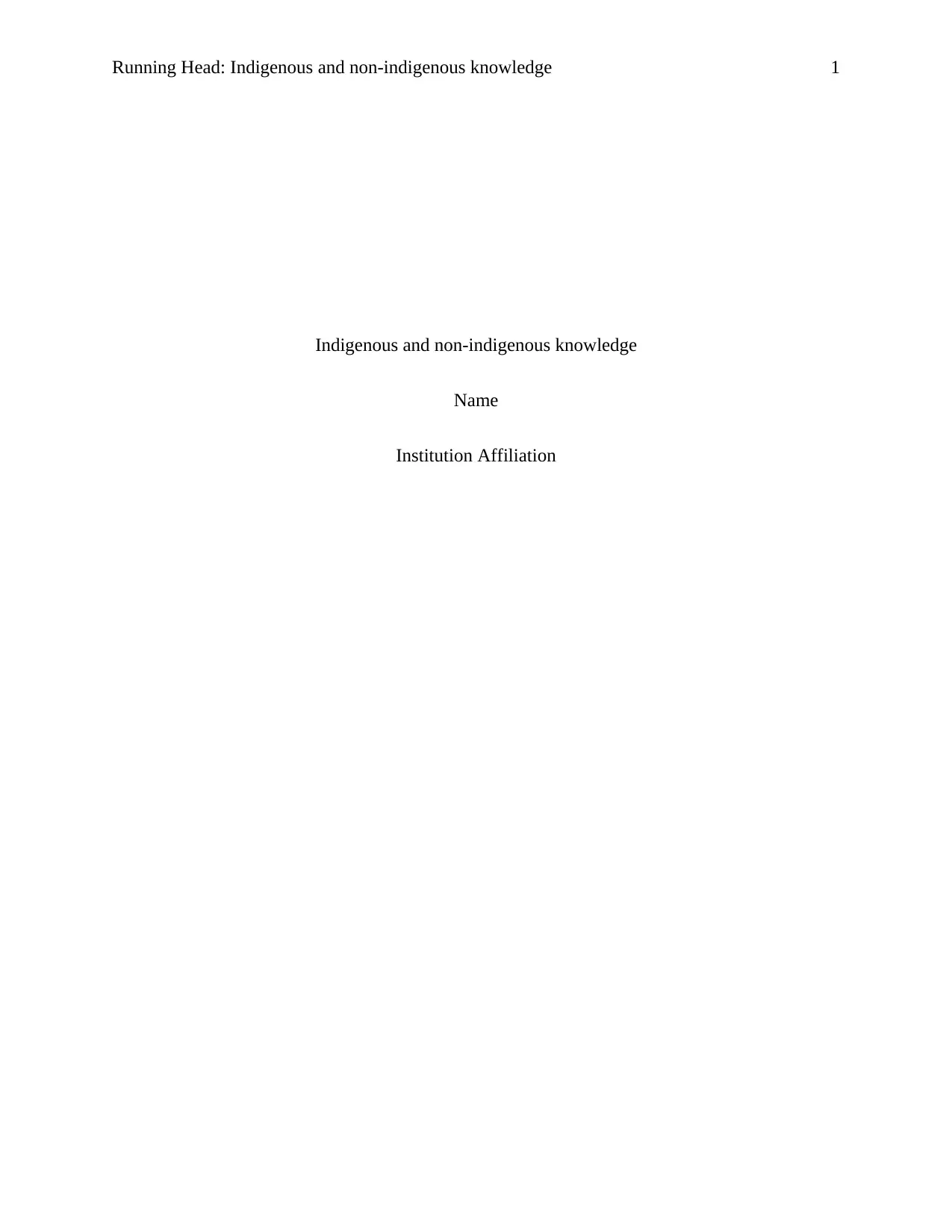
Running Head: Indigenous and non-indigenous knowledge 1
Indigenous and non-indigenous knowledge
Name
Institution Affiliation
Indigenous and non-indigenous knowledge
Name
Institution Affiliation
Secure Best Marks with AI Grader
Need help grading? Try our AI Grader for instant feedback on your assignments.
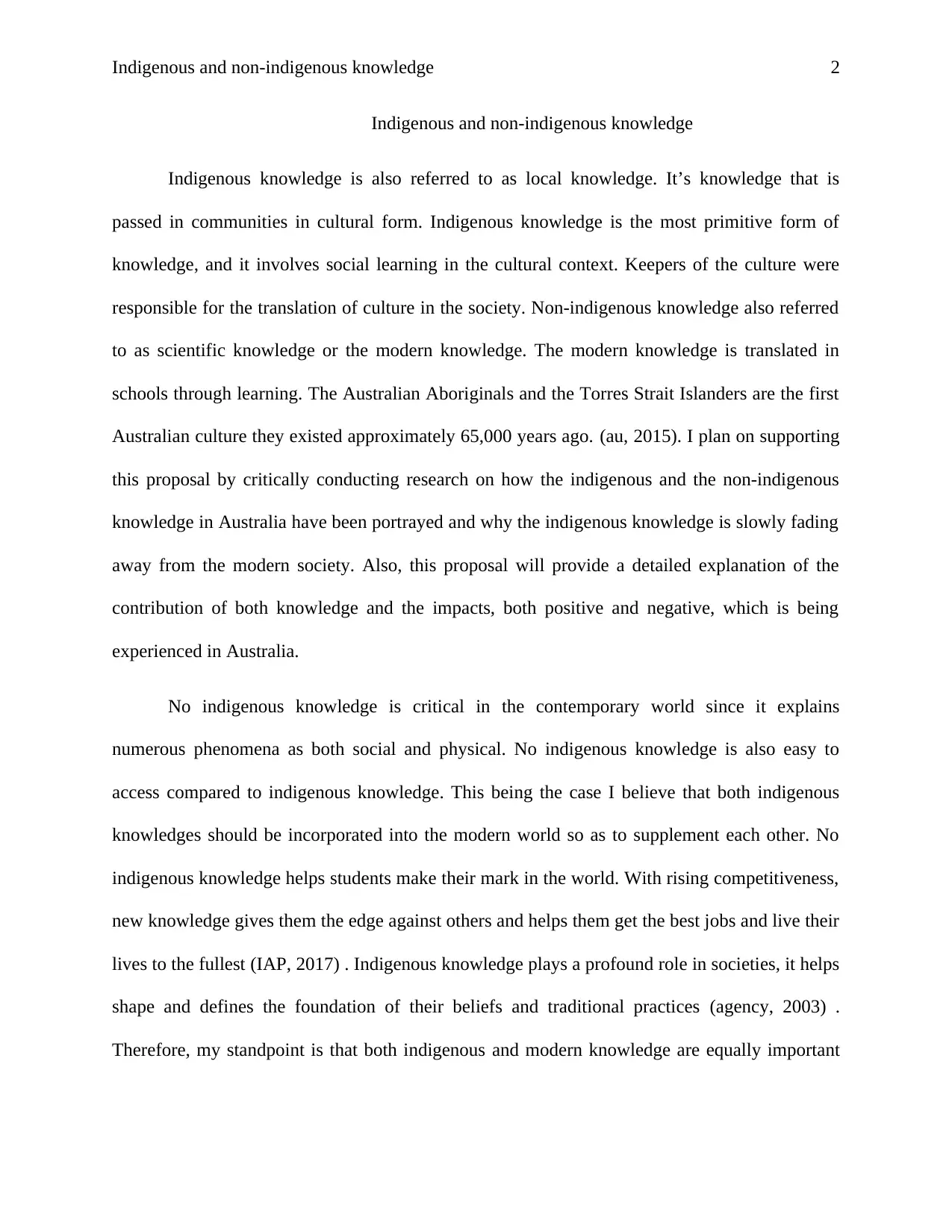
Indigenous and non-indigenous knowledge 2
Indigenous and non-indigenous knowledge
Indigenous knowledge is also referred to as local knowledge. It’s knowledge that is
passed in communities in cultural form. Indigenous knowledge is the most primitive form of
knowledge, and it involves social learning in the cultural context. Keepers of the culture were
responsible for the translation of culture in the society. Non-indigenous knowledge also referred
to as scientific knowledge or the modern knowledge. The modern knowledge is translated in
schools through learning. The Australian Aboriginals and the Torres Strait Islanders are the first
Australian culture they existed approximately 65,000 years ago. (au, 2015). I plan on supporting
this proposal by critically conducting research on how the indigenous and the non-indigenous
knowledge in Australia have been portrayed and why the indigenous knowledge is slowly fading
away from the modern society. Also, this proposal will provide a detailed explanation of the
contribution of both knowledge and the impacts, both positive and negative, which is being
experienced in Australia.
No indigenous knowledge is critical in the contemporary world since it explains
numerous phenomena as both social and physical. No indigenous knowledge is also easy to
access compared to indigenous knowledge. This being the case I believe that both indigenous
knowledges should be incorporated into the modern world so as to supplement each other. No
indigenous knowledge helps students make their mark in the world. With rising competitiveness,
new knowledge gives them the edge against others and helps them get the best jobs and live their
lives to the fullest (IAP, 2017) . Indigenous knowledge plays a profound role in societies, it helps
shape and defines the foundation of their beliefs and traditional practices (agency, 2003) .
Therefore, my standpoint is that both indigenous and modern knowledge are equally important
Indigenous and non-indigenous knowledge
Indigenous knowledge is also referred to as local knowledge. It’s knowledge that is
passed in communities in cultural form. Indigenous knowledge is the most primitive form of
knowledge, and it involves social learning in the cultural context. Keepers of the culture were
responsible for the translation of culture in the society. Non-indigenous knowledge also referred
to as scientific knowledge or the modern knowledge. The modern knowledge is translated in
schools through learning. The Australian Aboriginals and the Torres Strait Islanders are the first
Australian culture they existed approximately 65,000 years ago. (au, 2015). I plan on supporting
this proposal by critically conducting research on how the indigenous and the non-indigenous
knowledge in Australia have been portrayed and why the indigenous knowledge is slowly fading
away from the modern society. Also, this proposal will provide a detailed explanation of the
contribution of both knowledge and the impacts, both positive and negative, which is being
experienced in Australia.
No indigenous knowledge is critical in the contemporary world since it explains
numerous phenomena as both social and physical. No indigenous knowledge is also easy to
access compared to indigenous knowledge. This being the case I believe that both indigenous
knowledges should be incorporated into the modern world so as to supplement each other. No
indigenous knowledge helps students make their mark in the world. With rising competitiveness,
new knowledge gives them the edge against others and helps them get the best jobs and live their
lives to the fullest (IAP, 2017) . Indigenous knowledge plays a profound role in societies, it helps
shape and defines the foundation of their beliefs and traditional practices (agency, 2003) .
Therefore, my standpoint is that both indigenous and modern knowledge are equally important
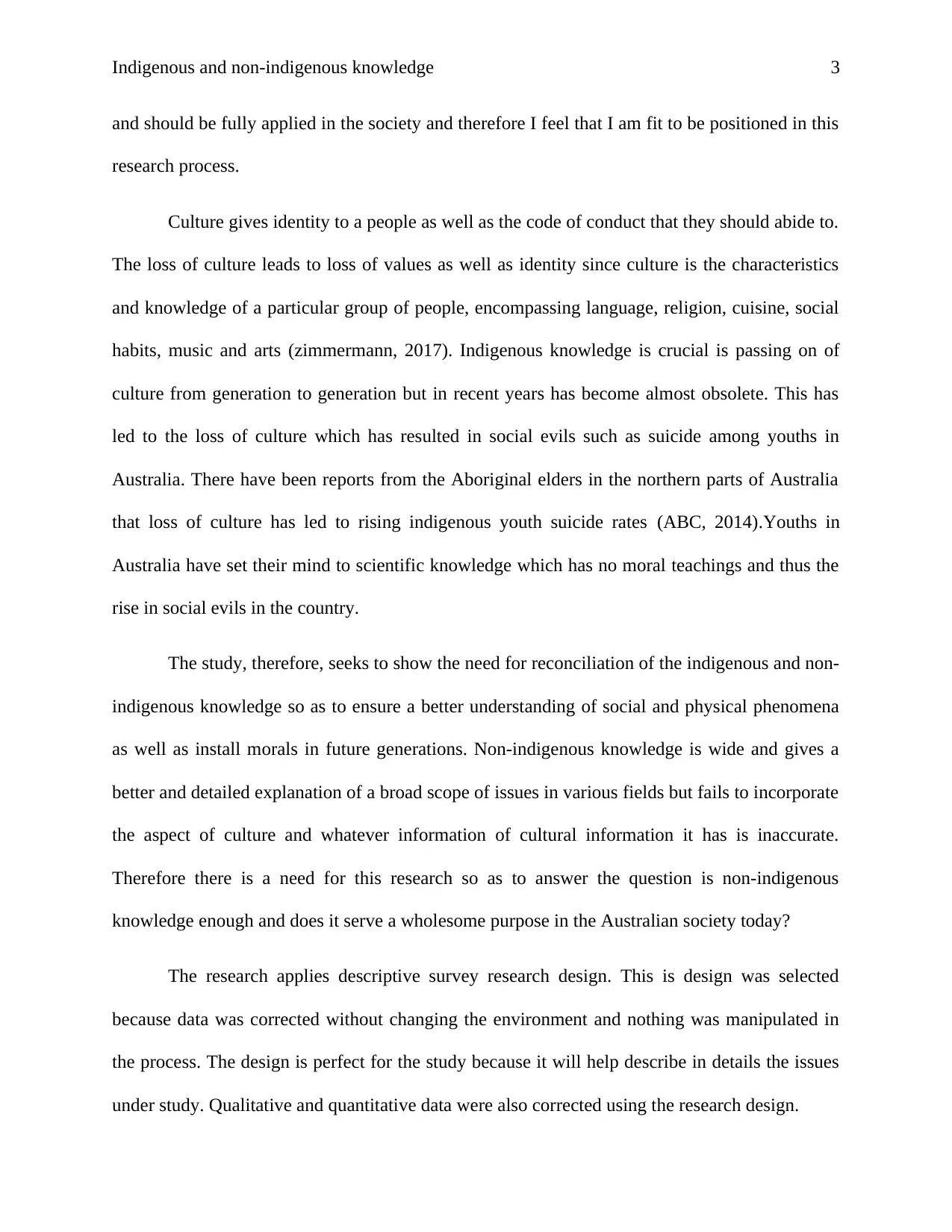
Indigenous and non-indigenous knowledge 3
and should be fully applied in the society and therefore I feel that I am fit to be positioned in this
research process.
Culture gives identity to a people as well as the code of conduct that they should abide to.
The loss of culture leads to loss of values as well as identity since culture is the characteristics
and knowledge of a particular group of people, encompassing language, religion, cuisine, social
habits, music and arts (zimmermann, 2017). Indigenous knowledge is crucial is passing on of
culture from generation to generation but in recent years has become almost obsolete. This has
led to the loss of culture which has resulted in social evils such as suicide among youths in
Australia. There have been reports from the Aboriginal elders in the northern parts of Australia
that loss of culture has led to rising indigenous youth suicide rates (ABC, 2014).Youths in
Australia have set their mind to scientific knowledge which has no moral teachings and thus the
rise in social evils in the country.
The study, therefore, seeks to show the need for reconciliation of the indigenous and non-
indigenous knowledge so as to ensure a better understanding of social and physical phenomena
as well as install morals in future generations. Non-indigenous knowledge is wide and gives a
better and detailed explanation of a broad scope of issues in various fields but fails to incorporate
the aspect of culture and whatever information of cultural information it has is inaccurate.
Therefore there is a need for this research so as to answer the question is non-indigenous
knowledge enough and does it serve a wholesome purpose in the Australian society today?
The research applies descriptive survey research design. This is design was selected
because data was corrected without changing the environment and nothing was manipulated in
the process. The design is perfect for the study because it will help describe in details the issues
under study. Qualitative and quantitative data were also corrected using the research design.
and should be fully applied in the society and therefore I feel that I am fit to be positioned in this
research process.
Culture gives identity to a people as well as the code of conduct that they should abide to.
The loss of culture leads to loss of values as well as identity since culture is the characteristics
and knowledge of a particular group of people, encompassing language, religion, cuisine, social
habits, music and arts (zimmermann, 2017). Indigenous knowledge is crucial is passing on of
culture from generation to generation but in recent years has become almost obsolete. This has
led to the loss of culture which has resulted in social evils such as suicide among youths in
Australia. There have been reports from the Aboriginal elders in the northern parts of Australia
that loss of culture has led to rising indigenous youth suicide rates (ABC, 2014).Youths in
Australia have set their mind to scientific knowledge which has no moral teachings and thus the
rise in social evils in the country.
The study, therefore, seeks to show the need for reconciliation of the indigenous and non-
indigenous knowledge so as to ensure a better understanding of social and physical phenomena
as well as install morals in future generations. Non-indigenous knowledge is wide and gives a
better and detailed explanation of a broad scope of issues in various fields but fails to incorporate
the aspect of culture and whatever information of cultural information it has is inaccurate.
Therefore there is a need for this research so as to answer the question is non-indigenous
knowledge enough and does it serve a wholesome purpose in the Australian society today?
The research applies descriptive survey research design. This is design was selected
because data was corrected without changing the environment and nothing was manipulated in
the process. The design is perfect for the study because it will help describe in details the issues
under study. Qualitative and quantitative data were also corrected using the research design.
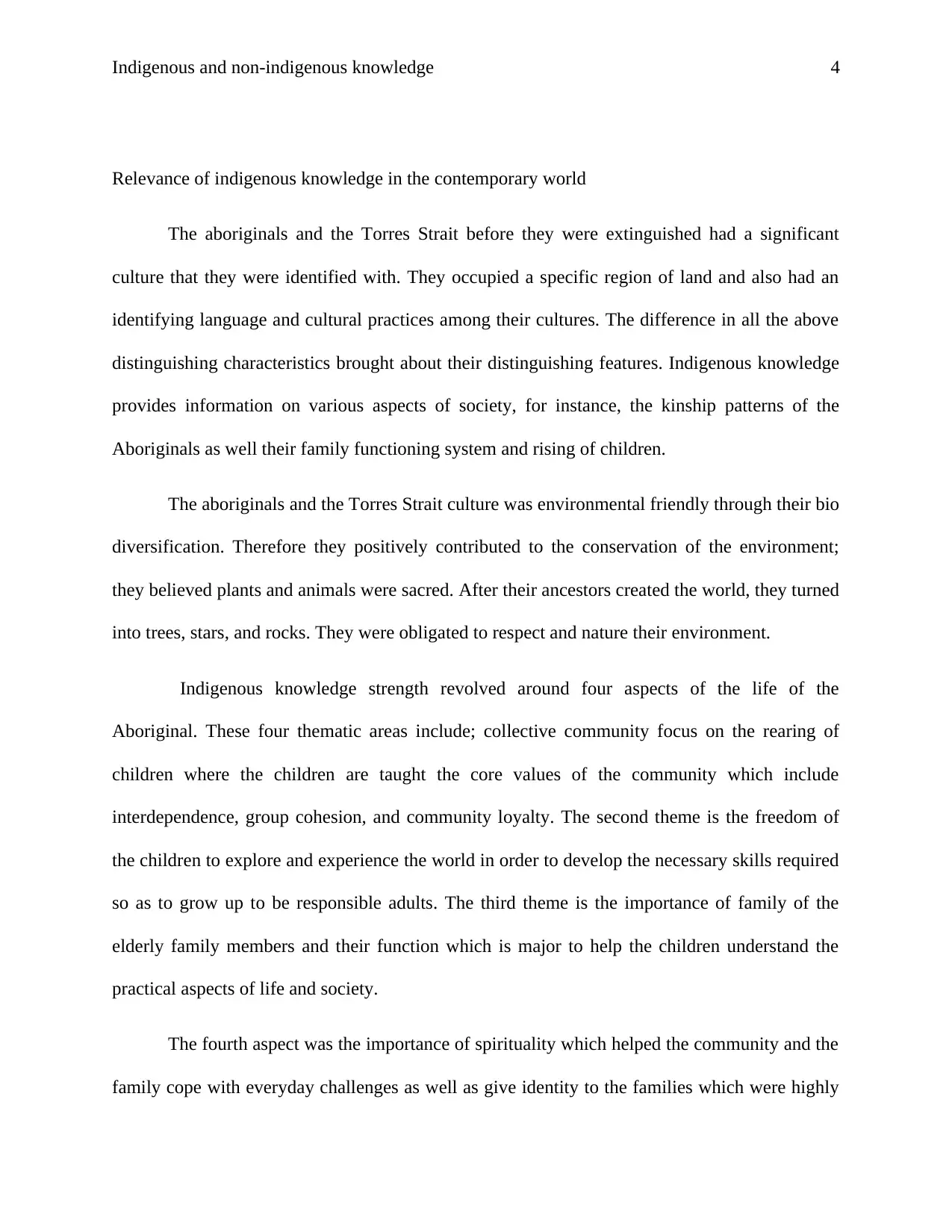
Indigenous and non-indigenous knowledge 4
Relevance of indigenous knowledge in the contemporary world
The aboriginals and the Torres Strait before they were extinguished had a significant
culture that they were identified with. They occupied a specific region of land and also had an
identifying language and cultural practices among their cultures. The difference in all the above
distinguishing characteristics brought about their distinguishing features. Indigenous knowledge
provides information on various aspects of society, for instance, the kinship patterns of the
Aboriginals as well their family functioning system and rising of children.
The aboriginals and the Torres Strait culture was environmental friendly through their bio
diversification. Therefore they positively contributed to the conservation of the environment;
they believed plants and animals were sacred. After their ancestors created the world, they turned
into trees, stars, and rocks. They were obligated to respect and nature their environment.
Indigenous knowledge strength revolved around four aspects of the life of the
Aboriginal. These four thematic areas include; collective community focus on the rearing of
children where the children are taught the core values of the community which include
interdependence, group cohesion, and community loyalty. The second theme is the freedom of
the children to explore and experience the world in order to develop the necessary skills required
so as to grow up to be responsible adults. The third theme is the importance of family of the
elderly family members and their function which is major to help the children understand the
practical aspects of life and society.
The fourth aspect was the importance of spirituality which helped the community and the
family cope with everyday challenges as well as give identity to the families which were highly
Relevance of indigenous knowledge in the contemporary world
The aboriginals and the Torres Strait before they were extinguished had a significant
culture that they were identified with. They occupied a specific region of land and also had an
identifying language and cultural practices among their cultures. The difference in all the above
distinguishing characteristics brought about their distinguishing features. Indigenous knowledge
provides information on various aspects of society, for instance, the kinship patterns of the
Aboriginals as well their family functioning system and rising of children.
The aboriginals and the Torres Strait culture was environmental friendly through their bio
diversification. Therefore they positively contributed to the conservation of the environment;
they believed plants and animals were sacred. After their ancestors created the world, they turned
into trees, stars, and rocks. They were obligated to respect and nature their environment.
Indigenous knowledge strength revolved around four aspects of the life of the
Aboriginal. These four thematic areas include; collective community focus on the rearing of
children where the children are taught the core values of the community which include
interdependence, group cohesion, and community loyalty. The second theme is the freedom of
the children to explore and experience the world in order to develop the necessary skills required
so as to grow up to be responsible adults. The third theme is the importance of family of the
elderly family members and their function which is major to help the children understand the
practical aspects of life and society.
The fourth aspect was the importance of spirituality which helped the community and the
family cope with everyday challenges as well as give identity to the families which were highly
Secure Best Marks with AI Grader
Need help grading? Try our AI Grader for instant feedback on your assignments.
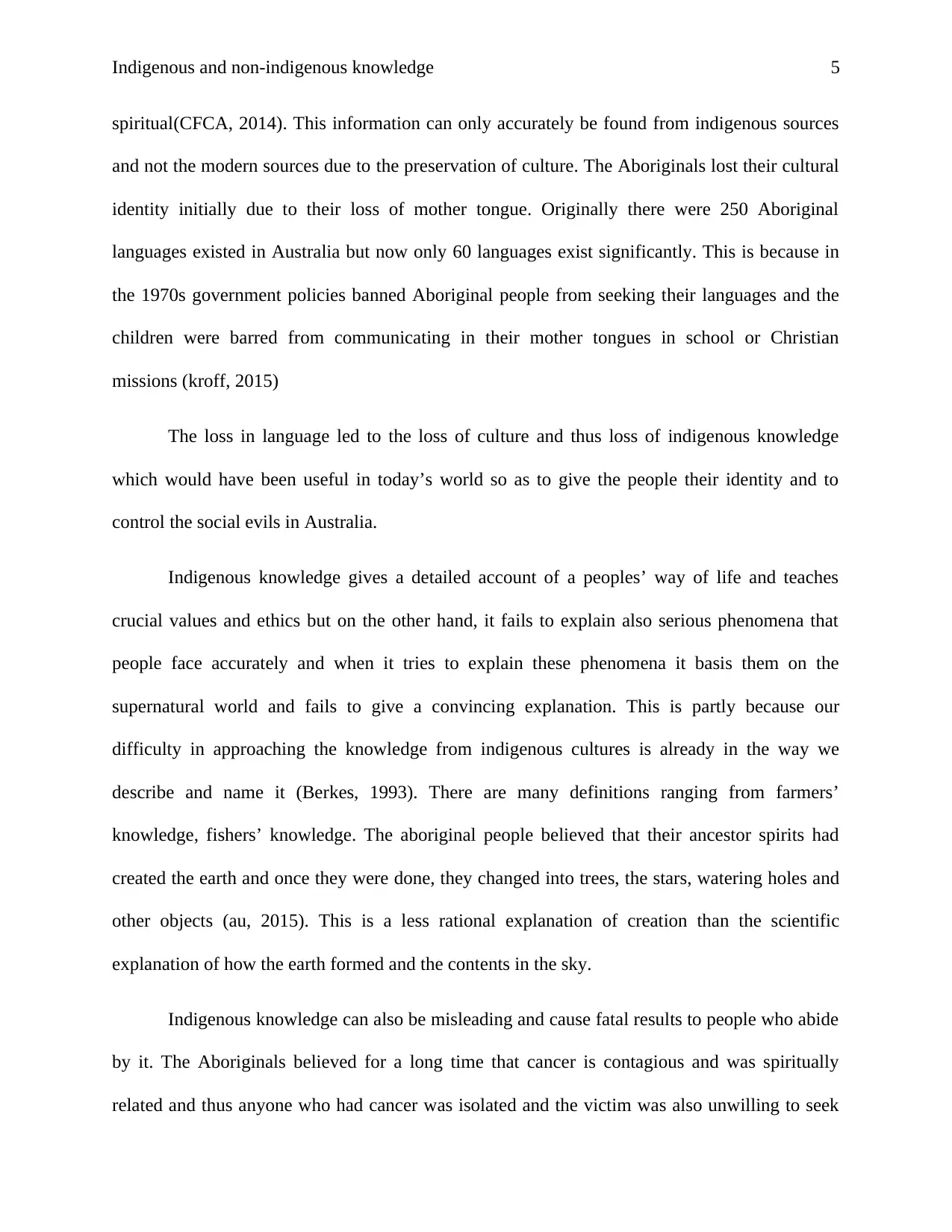
Indigenous and non-indigenous knowledge 5
spiritual(CFCA, 2014). This information can only accurately be found from indigenous sources
and not the modern sources due to the preservation of culture. The Aboriginals lost their cultural
identity initially due to their loss of mother tongue. Originally there were 250 Aboriginal
languages existed in Australia but now only 60 languages exist significantly. This is because in
the 1970s government policies banned Aboriginal people from seeking their languages and the
children were barred from communicating in their mother tongues in school or Christian
missions (kroff, 2015)
The loss in language led to the loss of culture and thus loss of indigenous knowledge
which would have been useful in today’s world so as to give the people their identity and to
control the social evils in Australia.
Indigenous knowledge gives a detailed account of a peoples’ way of life and teaches
crucial values and ethics but on the other hand, it fails to explain also serious phenomena that
people face accurately and when it tries to explain these phenomena it basis them on the
supernatural world and fails to give a convincing explanation. This is partly because our
difficulty in approaching the knowledge from indigenous cultures is already in the way we
describe and name it (Berkes, 1993). There are many definitions ranging from farmers’
knowledge, fishers’ knowledge. The aboriginal people believed that their ancestor spirits had
created the earth and once they were done, they changed into trees, the stars, watering holes and
other objects (au, 2015). This is a less rational explanation of creation than the scientific
explanation of how the earth formed and the contents in the sky.
Indigenous knowledge can also be misleading and cause fatal results to people who abide
by it. The Aboriginals believed for a long time that cancer is contagious and was spiritually
related and thus anyone who had cancer was isolated and the victim was also unwilling to seek
spiritual(CFCA, 2014). This information can only accurately be found from indigenous sources
and not the modern sources due to the preservation of culture. The Aboriginals lost their cultural
identity initially due to their loss of mother tongue. Originally there were 250 Aboriginal
languages existed in Australia but now only 60 languages exist significantly. This is because in
the 1970s government policies banned Aboriginal people from seeking their languages and the
children were barred from communicating in their mother tongues in school or Christian
missions (kroff, 2015)
The loss in language led to the loss of culture and thus loss of indigenous knowledge
which would have been useful in today’s world so as to give the people their identity and to
control the social evils in Australia.
Indigenous knowledge gives a detailed account of a peoples’ way of life and teaches
crucial values and ethics but on the other hand, it fails to explain also serious phenomena that
people face accurately and when it tries to explain these phenomena it basis them on the
supernatural world and fails to give a convincing explanation. This is partly because our
difficulty in approaching the knowledge from indigenous cultures is already in the way we
describe and name it (Berkes, 1993). There are many definitions ranging from farmers’
knowledge, fishers’ knowledge. The aboriginal people believed that their ancestor spirits had
created the earth and once they were done, they changed into trees, the stars, watering holes and
other objects (au, 2015). This is a less rational explanation of creation than the scientific
explanation of how the earth formed and the contents in the sky.
Indigenous knowledge can also be misleading and cause fatal results to people who abide
by it. The Aboriginals believed for a long time that cancer is contagious and was spiritually
related and thus anyone who had cancer was isolated and the victim was also unwilling to seek
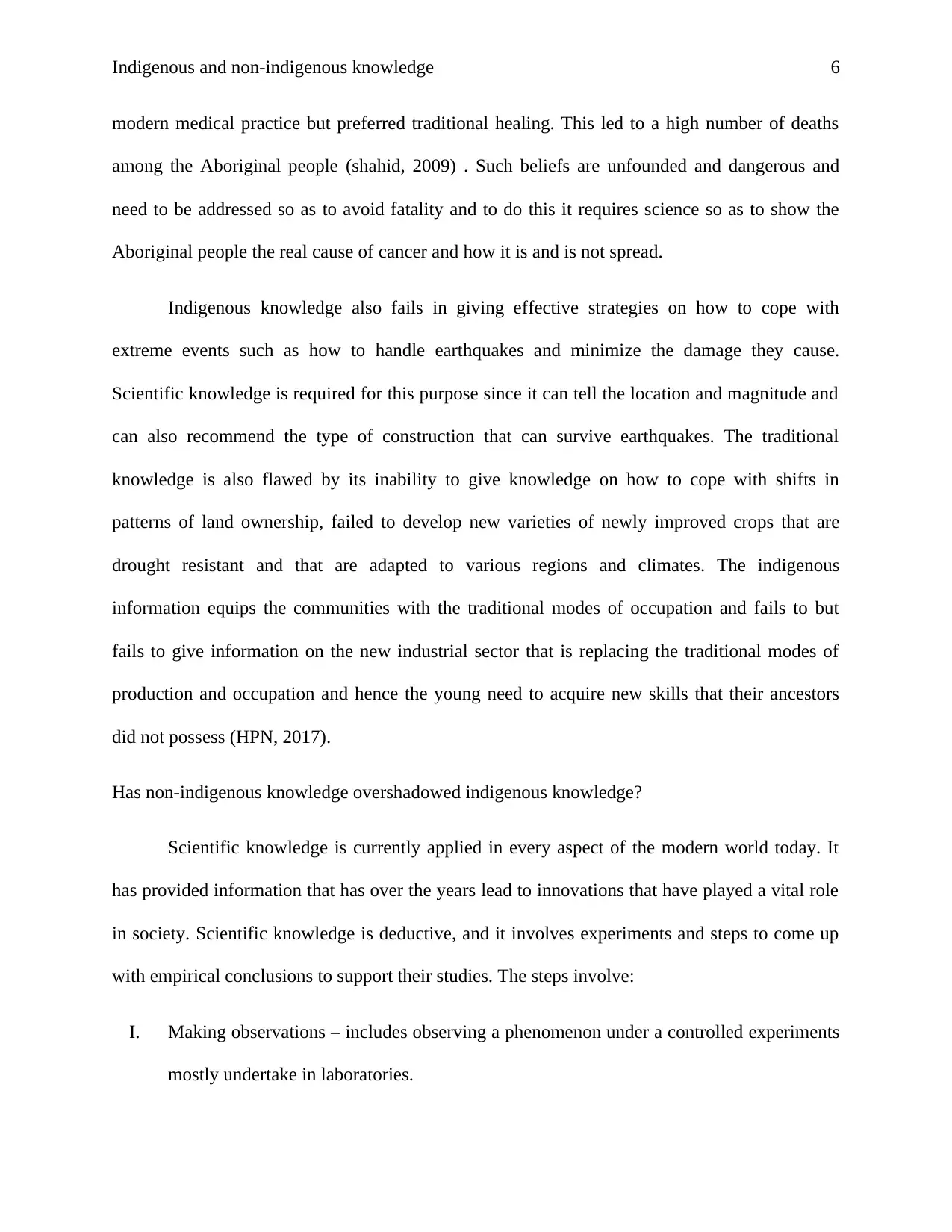
Indigenous and non-indigenous knowledge 6
modern medical practice but preferred traditional healing. This led to a high number of deaths
among the Aboriginal people (shahid, 2009) . Such beliefs are unfounded and dangerous and
need to be addressed so as to avoid fatality and to do this it requires science so as to show the
Aboriginal people the real cause of cancer and how it is and is not spread.
Indigenous knowledge also fails in giving effective strategies on how to cope with
extreme events such as how to handle earthquakes and minimize the damage they cause.
Scientific knowledge is required for this purpose since it can tell the location and magnitude and
can also recommend the type of construction that can survive earthquakes. The traditional
knowledge is also flawed by its inability to give knowledge on how to cope with shifts in
patterns of land ownership, failed to develop new varieties of newly improved crops that are
drought resistant and that are adapted to various regions and climates. The indigenous
information equips the communities with the traditional modes of occupation and fails to but
fails to give information on the new industrial sector that is replacing the traditional modes of
production and occupation and hence the young need to acquire new skills that their ancestors
did not possess (HPN, 2017).
Has non-indigenous knowledge overshadowed indigenous knowledge?
Scientific knowledge is currently applied in every aspect of the modern world today. It
has provided information that has over the years lead to innovations that have played a vital role
in society. Scientific knowledge is deductive, and it involves experiments and steps to come up
with empirical conclusions to support their studies. The steps involve:
I. Making observations – includes observing a phenomenon under a controlled experiments
mostly undertake in laboratories.
modern medical practice but preferred traditional healing. This led to a high number of deaths
among the Aboriginal people (shahid, 2009) . Such beliefs are unfounded and dangerous and
need to be addressed so as to avoid fatality and to do this it requires science so as to show the
Aboriginal people the real cause of cancer and how it is and is not spread.
Indigenous knowledge also fails in giving effective strategies on how to cope with
extreme events such as how to handle earthquakes and minimize the damage they cause.
Scientific knowledge is required for this purpose since it can tell the location and magnitude and
can also recommend the type of construction that can survive earthquakes. The traditional
knowledge is also flawed by its inability to give knowledge on how to cope with shifts in
patterns of land ownership, failed to develop new varieties of newly improved crops that are
drought resistant and that are adapted to various regions and climates. The indigenous
information equips the communities with the traditional modes of occupation and fails to but
fails to give information on the new industrial sector that is replacing the traditional modes of
production and occupation and hence the young need to acquire new skills that their ancestors
did not possess (HPN, 2017).
Has non-indigenous knowledge overshadowed indigenous knowledge?
Scientific knowledge is currently applied in every aspect of the modern world today. It
has provided information that has over the years lead to innovations that have played a vital role
in society. Scientific knowledge is deductive, and it involves experiments and steps to come up
with empirical conclusions to support their studies. The steps involve:
I. Making observations – includes observing a phenomenon under a controlled experiments
mostly undertake in laboratories.
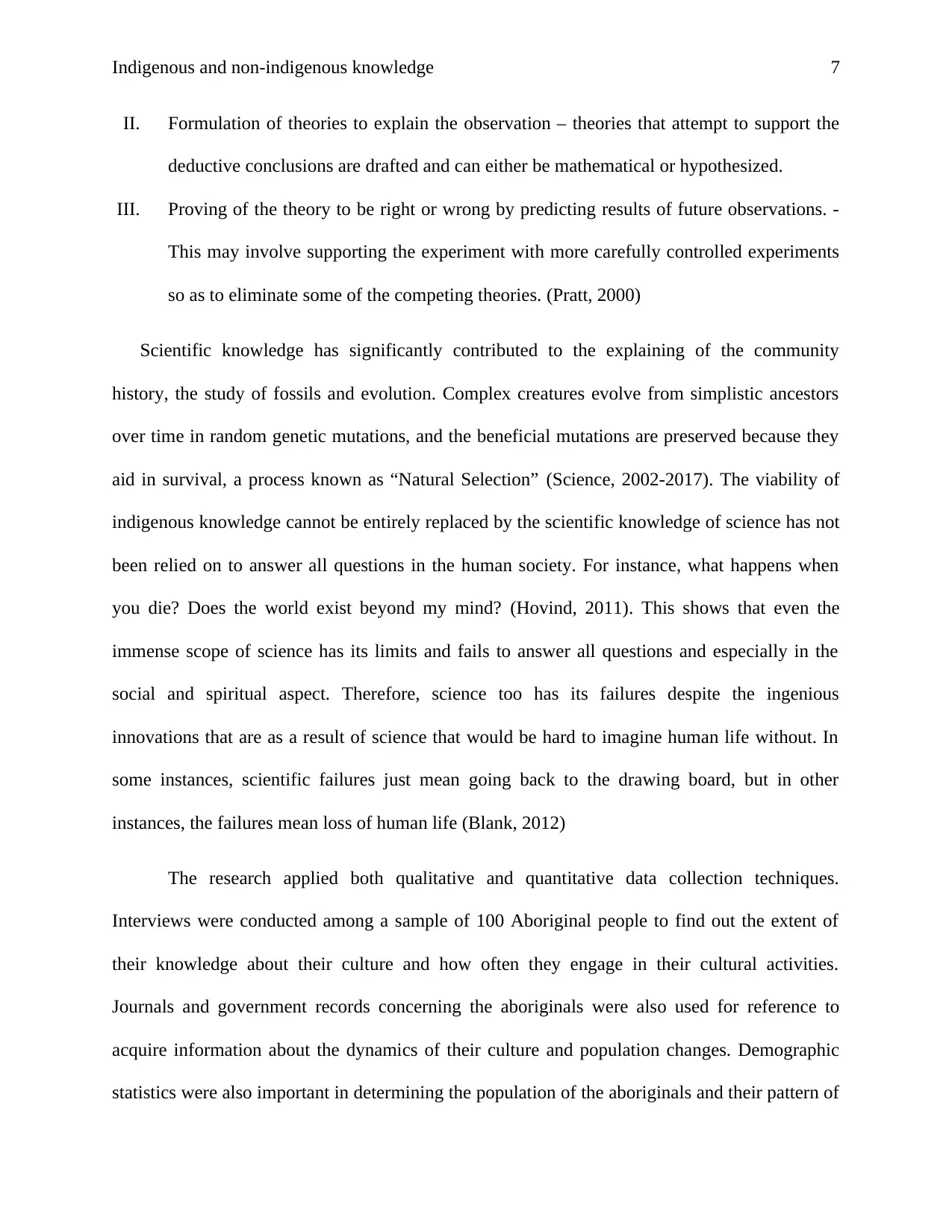
Indigenous and non-indigenous knowledge 7
II. Formulation of theories to explain the observation – theories that attempt to support the
deductive conclusions are drafted and can either be mathematical or hypothesized.
III. Proving of the theory to be right or wrong by predicting results of future observations. -
This may involve supporting the experiment with more carefully controlled experiments
so as to eliminate some of the competing theories. (Pratt, 2000)
Scientific knowledge has significantly contributed to the explaining of the community
history, the study of fossils and evolution. Complex creatures evolve from simplistic ancestors
over time in random genetic mutations, and the beneficial mutations are preserved because they
aid in survival, a process known as “Natural Selection” (Science, 2002-2017). The viability of
indigenous knowledge cannot be entirely replaced by the scientific knowledge of science has not
been relied on to answer all questions in the human society. For instance, what happens when
you die? Does the world exist beyond my mind? (Hovind, 2011). This shows that even the
immense scope of science has its limits and fails to answer all questions and especially in the
social and spiritual aspect. Therefore, science too has its failures despite the ingenious
innovations that are as a result of science that would be hard to imagine human life without. In
some instances, scientific failures just mean going back to the drawing board, but in other
instances, the failures mean loss of human life (Blank, 2012)
The research applied both qualitative and quantitative data collection techniques.
Interviews were conducted among a sample of 100 Aboriginal people to find out the extent of
their knowledge about their culture and how often they engage in their cultural activities.
Journals and government records concerning the aboriginals were also used for reference to
acquire information about the dynamics of their culture and population changes. Demographic
statistics were also important in determining the population of the aboriginals and their pattern of
II. Formulation of theories to explain the observation – theories that attempt to support the
deductive conclusions are drafted and can either be mathematical or hypothesized.
III. Proving of the theory to be right or wrong by predicting results of future observations. -
This may involve supporting the experiment with more carefully controlled experiments
so as to eliminate some of the competing theories. (Pratt, 2000)
Scientific knowledge has significantly contributed to the explaining of the community
history, the study of fossils and evolution. Complex creatures evolve from simplistic ancestors
over time in random genetic mutations, and the beneficial mutations are preserved because they
aid in survival, a process known as “Natural Selection” (Science, 2002-2017). The viability of
indigenous knowledge cannot be entirely replaced by the scientific knowledge of science has not
been relied on to answer all questions in the human society. For instance, what happens when
you die? Does the world exist beyond my mind? (Hovind, 2011). This shows that even the
immense scope of science has its limits and fails to answer all questions and especially in the
social and spiritual aspect. Therefore, science too has its failures despite the ingenious
innovations that are as a result of science that would be hard to imagine human life without. In
some instances, scientific failures just mean going back to the drawing board, but in other
instances, the failures mean loss of human life (Blank, 2012)
The research applied both qualitative and quantitative data collection techniques.
Interviews were conducted among a sample of 100 Aboriginal people to find out the extent of
their knowledge about their culture and how often they engage in their cultural activities.
Journals and government records concerning the aboriginals were also used for reference to
acquire information about the dynamics of their culture and population changes. Demographic
statistics were also important in determining the population of the aboriginals and their pattern of
Paraphrase This Document
Need a fresh take? Get an instant paraphrase of this document with our AI Paraphraser
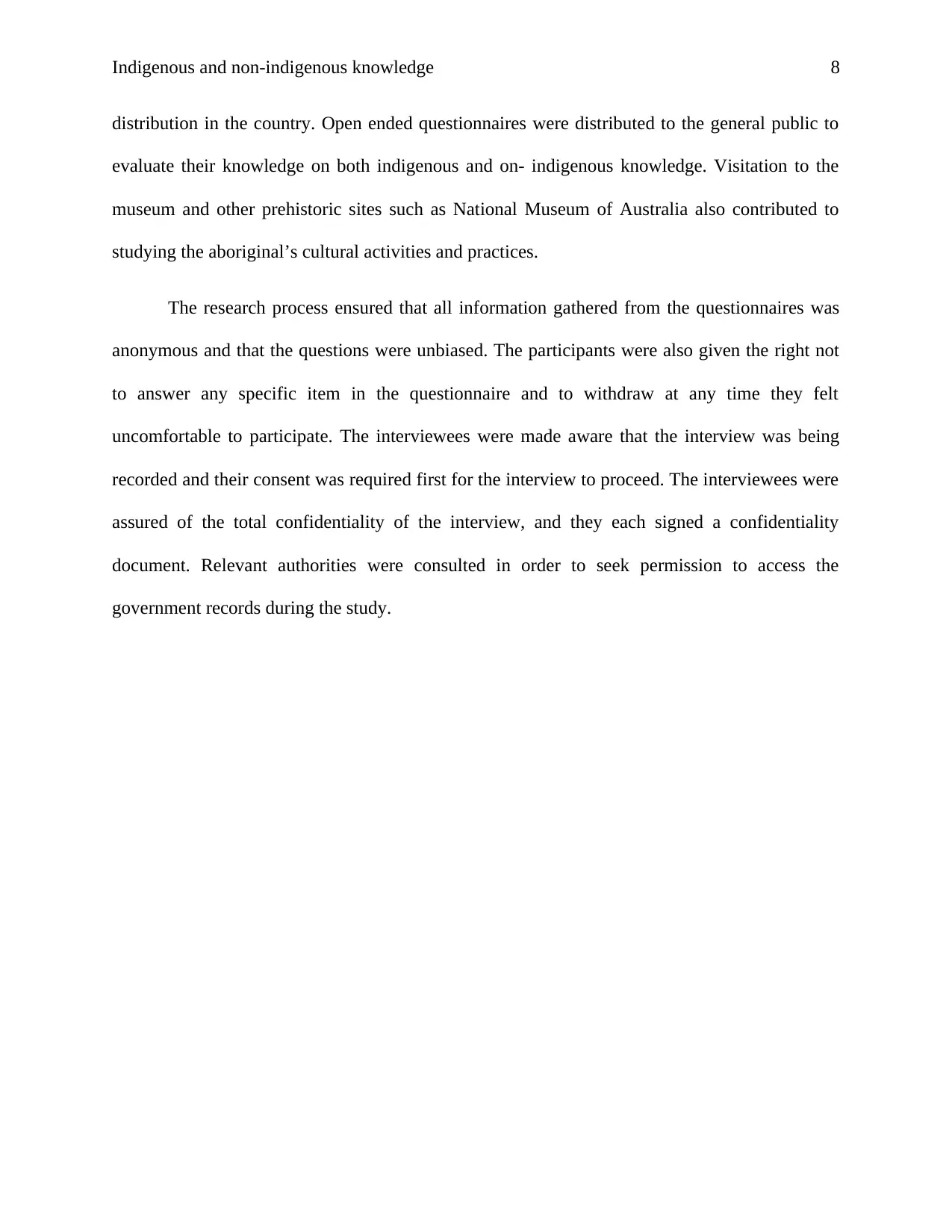
Indigenous and non-indigenous knowledge 8
distribution in the country. Open ended questionnaires were distributed to the general public to
evaluate their knowledge on both indigenous and on- indigenous knowledge. Visitation to the
museum and other prehistoric sites such as National Museum of Australia also contributed to
studying the aboriginal’s cultural activities and practices.
The research process ensured that all information gathered from the questionnaires was
anonymous and that the questions were unbiased. The participants were also given the right not
to answer any specific item in the questionnaire and to withdraw at any time they felt
uncomfortable to participate. The interviewees were made aware that the interview was being
recorded and their consent was required first for the interview to proceed. The interviewees were
assured of the total confidentiality of the interview, and they each signed a confidentiality
document. Relevant authorities were consulted in order to seek permission to access the
government records during the study.
distribution in the country. Open ended questionnaires were distributed to the general public to
evaluate their knowledge on both indigenous and on- indigenous knowledge. Visitation to the
museum and other prehistoric sites such as National Museum of Australia also contributed to
studying the aboriginal’s cultural activities and practices.
The research process ensured that all information gathered from the questionnaires was
anonymous and that the questions were unbiased. The participants were also given the right not
to answer any specific item in the questionnaire and to withdraw at any time they felt
uncomfortable to participate. The interviewees were made aware that the interview was being
recorded and their consent was required first for the interview to proceed. The interviewees were
assured of the total confidentiality of the interview, and they each signed a confidentiality
document. Relevant authorities were consulted in order to seek permission to access the
government records during the study.
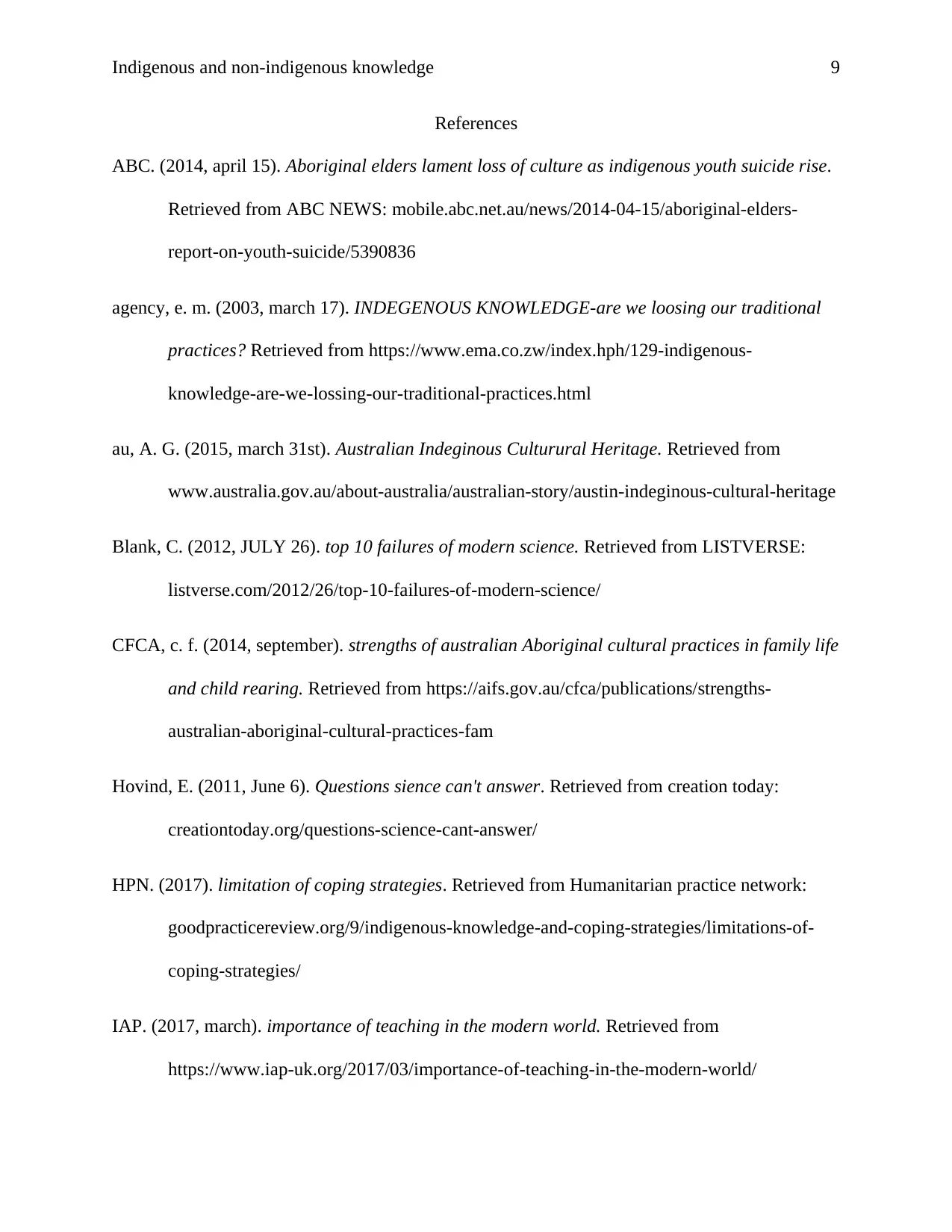
Indigenous and non-indigenous knowledge 9
References
ABC. (2014, april 15). Aboriginal elders lament loss of culture as indigenous youth suicide rise.
Retrieved from ABC NEWS: mobile.abc.net.au/news/2014-04-15/aboriginal-elders-
report-on-youth-suicide/5390836
agency, e. m. (2003, march 17). INDEGENOUS KNOWLEDGE-are we loosing our traditional
practices? Retrieved from https://www.ema.co.zw/index.hph/129-indigenous-
knowledge-are-we-lossing-our-traditional-practices.html
au, A. G. (2015, march 31st). Australian Indeginous Culturural Heritage. Retrieved from
www.australia.gov.au/about-australia/australian-story/austin-indeginous-cultural-heritage
Blank, C. (2012, JULY 26). top 10 failures of modern science. Retrieved from LISTVERSE:
listverse.com/2012/26/top-10-failures-of-modern-science/
CFCA, c. f. (2014, september). strengths of australian Aboriginal cultural practices in family life
and child rearing. Retrieved from https://aifs.gov.au/cfca/publications/strengths-
australian-aboriginal-cultural-practices-fam
Hovind, E. (2011, June 6). Questions sience can't answer. Retrieved from creation today:
creationtoday.org/questions-science-cant-answer/
HPN. (2017). limitation of coping strategies. Retrieved from Humanitarian practice network:
goodpracticereview.org/9/indigenous-knowledge-and-coping-strategies/limitations-of-
coping-strategies/
IAP. (2017, march). importance of teaching in the modern world. Retrieved from
https://www.iap-uk.org/2017/03/importance-of-teaching-in-the-modern-world/
References
ABC. (2014, april 15). Aboriginal elders lament loss of culture as indigenous youth suicide rise.
Retrieved from ABC NEWS: mobile.abc.net.au/news/2014-04-15/aboriginal-elders-
report-on-youth-suicide/5390836
agency, e. m. (2003, march 17). INDEGENOUS KNOWLEDGE-are we loosing our traditional
practices? Retrieved from https://www.ema.co.zw/index.hph/129-indigenous-
knowledge-are-we-lossing-our-traditional-practices.html
au, A. G. (2015, march 31st). Australian Indeginous Culturural Heritage. Retrieved from
www.australia.gov.au/about-australia/australian-story/austin-indeginous-cultural-heritage
Blank, C. (2012, JULY 26). top 10 failures of modern science. Retrieved from LISTVERSE:
listverse.com/2012/26/top-10-failures-of-modern-science/
CFCA, c. f. (2014, september). strengths of australian Aboriginal cultural practices in family life
and child rearing. Retrieved from https://aifs.gov.au/cfca/publications/strengths-
australian-aboriginal-cultural-practices-fam
Hovind, E. (2011, June 6). Questions sience can't answer. Retrieved from creation today:
creationtoday.org/questions-science-cant-answer/
HPN. (2017). limitation of coping strategies. Retrieved from Humanitarian practice network:
goodpracticereview.org/9/indigenous-knowledge-and-coping-strategies/limitations-of-
coping-strategies/
IAP. (2017, march). importance of teaching in the modern world. Retrieved from
https://www.iap-uk.org/2017/03/importance-of-teaching-in-the-modern-world/
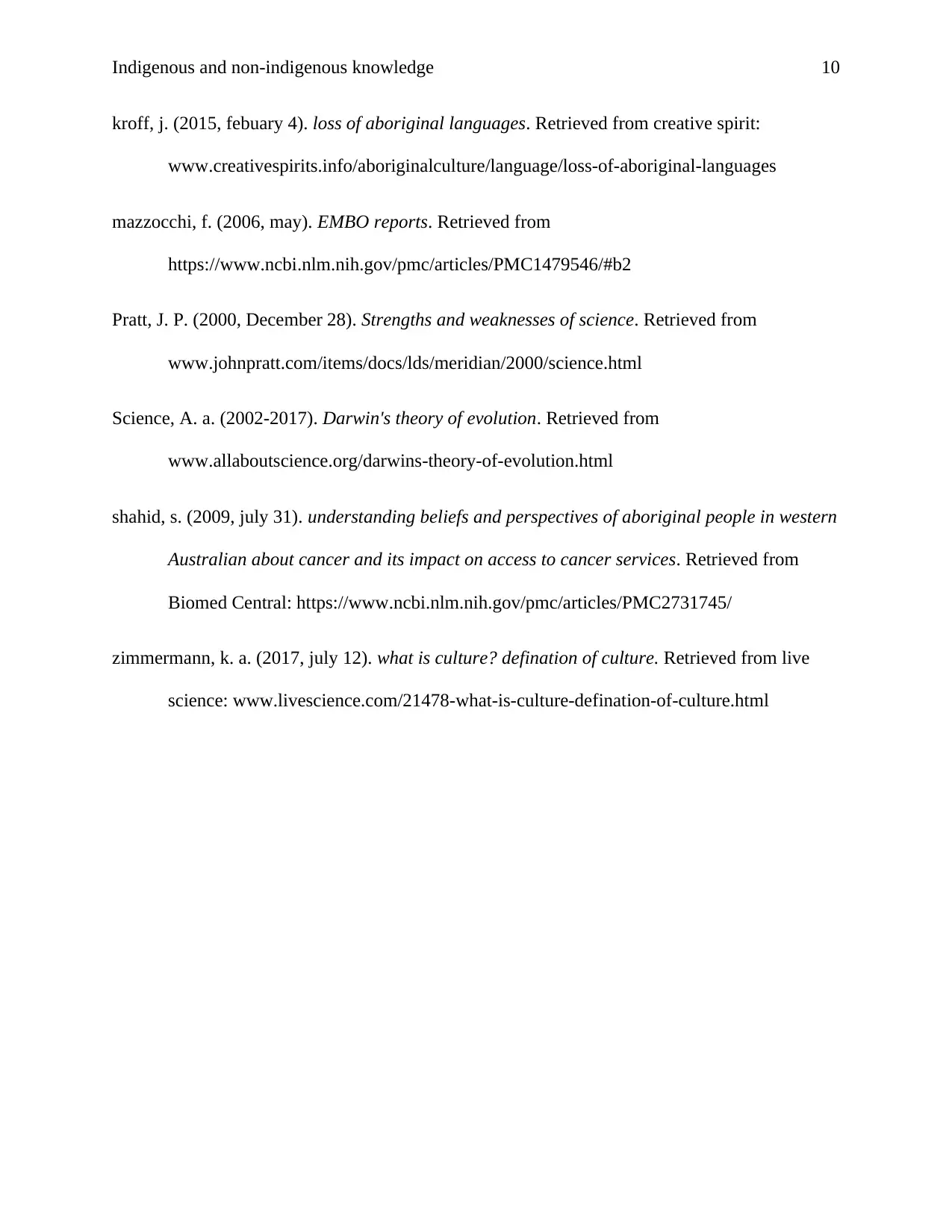
Indigenous and non-indigenous knowledge 10
kroff, j. (2015, febuary 4). loss of aboriginal languages. Retrieved from creative spirit:
www.creativespirits.info/aboriginalculture/language/loss-of-aboriginal-languages
mazzocchi, f. (2006, may). EMBO reports. Retrieved from
https://www.ncbi.nlm.nih.gov/pmc/articles/PMC1479546/#b2
Pratt, J. P. (2000, December 28). Strengths and weaknesses of science. Retrieved from
www.johnpratt.com/items/docs/lds/meridian/2000/science.html
Science, A. a. (2002-2017). Darwin's theory of evolution. Retrieved from
www.allaboutscience.org/darwins-theory-of-evolution.html
shahid, s. (2009, july 31). understanding beliefs and perspectives of aboriginal people in western
Australian about cancer and its impact on access to cancer services. Retrieved from
Biomed Central: https://www.ncbi.nlm.nih.gov/pmc/articles/PMC2731745/
zimmermann, k. a. (2017, july 12). what is culture? defination of culture. Retrieved from live
science: www.livescience.com/21478-what-is-culture-defination-of-culture.html
kroff, j. (2015, febuary 4). loss of aboriginal languages. Retrieved from creative spirit:
www.creativespirits.info/aboriginalculture/language/loss-of-aboriginal-languages
mazzocchi, f. (2006, may). EMBO reports. Retrieved from
https://www.ncbi.nlm.nih.gov/pmc/articles/PMC1479546/#b2
Pratt, J. P. (2000, December 28). Strengths and weaknesses of science. Retrieved from
www.johnpratt.com/items/docs/lds/meridian/2000/science.html
Science, A. a. (2002-2017). Darwin's theory of evolution. Retrieved from
www.allaboutscience.org/darwins-theory-of-evolution.html
shahid, s. (2009, july 31). understanding beliefs and perspectives of aboriginal people in western
Australian about cancer and its impact on access to cancer services. Retrieved from
Biomed Central: https://www.ncbi.nlm.nih.gov/pmc/articles/PMC2731745/
zimmermann, k. a. (2017, july 12). what is culture? defination of culture. Retrieved from live
science: www.livescience.com/21478-what-is-culture-defination-of-culture.html
1 out of 10
Related Documents
Your All-in-One AI-Powered Toolkit for Academic Success.
+13062052269
info@desklib.com
Available 24*7 on WhatsApp / Email
![[object Object]](/_next/static/media/star-bottom.7253800d.svg)
Unlock your academic potential
© 2024 | Zucol Services PVT LTD | All rights reserved.





